DeVilbiss SRiPro Lite Micro Spray Gun Manuel utilisateur
- Catégorie
- Pulvérisateur de peinture
- Taper
- Manuel utilisateur
Ce manuel convient également à

EN
SRiPro Lite Micro
DEVILBISS
Contact your local Carlisle Fluid Technologies representative for additional copies of this manual.
IMPORTANT! DO NOT DESTROY
It is the Customer's responsibility to have all operators and service personnel read and understand
this manual.
READ ALL INSTRUCTIONS BEFORE OPERATING THIS PRODUCT.
SERVICE MANUAL
Gravity Spray Gun for micro, smart repairs and
small areas.
SB-2-512 R1 www.carlisleft.com

EN
P1 =
FUNCTIONAL DESCRIPTION
CONNECTIONS
Solvent resistant
Chrome plated steel
Trigger
SPECIFICATIONS
Fluid Tip, Fluid Needle and Trigger Stud
WEIGHT
Gun Air Inlet Pressure for High Efficiency and HVLP setups, with gun
triggered.
2.0 bar [29 psi]
Springs, Clips, Screws
Air Valve Assembly
Air Inlet Size
Universal 1/4" BSP and 1/4" NPS male
Fluid Inlet Size
7/16" - 14 UNC
Chrome plated brass
Gun Body, Air Cap Retaining Ring, Knobs
Anodized Aluminium
12 bar [175 psi]
Air Inlet, Body Bushing, Spreader Valve Body, Air Valve Nut
135 x 163 x 18
L x H x W mm
<2.5 m/s²
Stainless Steel, HDPE
Air Cap
Nickel plated brass
AIR INLET PRESSURES
ENVIRONMENTAL
Max Ambient Operating Temperature
104° F [40° C]
MATERIALS OF CONSTRUCTION
Stainless Steel
Vibration Level:
Sound Power Level:
Sound Pressure Level:
Available on request
Available on request
Seals, Gaskets
Max Static Air Input Pressure
Stainless Steel
GUN ONLY
The SRiPro Lite spray gun is a professional quality gun designed with both High Efficiency or high volume, low
pressure (HVLP) technology. HVLP technology reduces overspray and limits air cap pressure to 0.7 bar [10 psi],
(complies with rules issued by SCAQMD and other air quality authorities). High Efficiency technology, when
tested under recommended conditions, has been found to exceed 65% transfer efficiency.
IMPORTANT: This spraygun is suitable for use with both waterbased and solvent based coating materials. The
gun is not designed for use with highly corrosive and/or abrasive materials and if used with such materials it
must be expected that the need for cleaning and/or replacement of parts will be increased. If there is any doubt
regarding the suitability of a specific material, contact your DeVilbiss Distributor or DeVilbiss direct.
395g
DIMENSIONS
SB-2-512 R1
2/24
www.carlisleft.com

This Declaration of conformity / incorporation is issued under the sole responsiblity of the
manufacturer:
EU Declaration of Conformity
12-Feb-18
Protection Level:
Notified body details and role:
Product Description / Object of Declaration:
SRiPro Lite
This Product is designed for use with:
Solvent-based and waterborne materials
Suitable for use in hazardous area:
Zone 1 / Zone 2
II 2 G X
Element Materials Technology. WN8 9PN UK
Lodging of Technical file
Machinery Directive 2006/42/EC
ATEX Directive 2014/34/EU
by complying with the following statutory documents and harmonised standards:
EN ISO 12100:2010 Safety of Machinery - General Principles for Design
BS EN 1953:2013 Atomizing and spraying equipment for coating materials - Safety requirements
EN 1127-1:2011 Explosive atmospheres - Explosion prevention - Basic concepts
EN 13463-1:2009 Non electrical equipment for use in potentially explosive atmospheres - Basic methods and
requirements
Providing all conditions of safe use / installation stated within the product manuals have been complied with and
also installed in accordance with any applicable local codes of practice.
Signed for and on behalf of
Carlisle Fluid Technologies:
Dave Smith
Director of Sales (EMEA)
This Declaration of conformity /
incorporation is issued under the sole
responsiblity of the manufacturer:
Carlisle Fluid Technologies Ltd,
Ringwood Road,
Bournemouth, BH11 9LH. UK
SB-2-512 R1
3/24
www.carlisleft.com

EN
LOCK OUT / TAG-OUT. Failure to de-energise, disconnect, lock out and tag-
out all power sources before performing equipment maintenance could cause
serious injury or death.
In this part sheet, the words WARNING, CAUTION and NOTE are used to emphasise important safety information as
follows:
FIRE AND EXPLOSION HAZARD. Never use 1,1,1-Trichloroethane,
Methylene Chloride, other Halogenated Hydrocarbon solvents or fluids
containing such solvents in equipment with aluminium wetted parts. Such use
could result in a serious chemical reaction, with the posibility of explosion.
Consult your fluid suppliers to ensure that the fluids being used are compatible
with aluminium parts.
STATIC CHARGE. Fluid may develop a static charge that must be dissipated
through proper grounding of the equipment, objects to be sprayed and all other
electrically conductive objects in the dispensing area. Improper grounding or
sparks can cause a hazardous condition and result in fire, explosion or elecrtic
shock and other serious injury.
SOLVENTS AND COATING MATERIALS. Can be highly flammable or
combustible when sprayed. Always refer to the coating material supplier's
instructions and safety sheets before using this equipment.
READ THE MANUAL. Before operating finishing equipment, read and
understand all safety, operation and maintenance information provided in the
operation manual. Users must comply with all local and national codes of
practice and insurance company requirements governing ventilation, fire
precautions, operation and house-keeping of working areas.
EQUIPMENT MISUSE HAZARD. Equipment misuse can cause
the equipment to rupture, malfunction or start unexpectedly and
result in serious injury.
WARNING
CAUTION
Hazards or unsafe practices which could result in
minor personal injury, product or property
damage.
GLOVES. Must be worn when spraying or cleaning the
equipment.
Read the following warnings before using this equipment.
WARNING
WEAR SAFETY GLASSES. Failure to wear safety glasses with
side shields could result in serious eye injury or blindness.
WEAR RESPIRATOR. The use of respiratory protective
equipment is recommended at all times. The type of equipment
must be compatible with the material being sprayed.
NEVER MODIFY THE EQUIPMENT. Do not modify the
equipment unless the manufacturer provides written approval.
PRESSURE RELIEF PROCEDURE. Always follow the pressure
relief procedure in the equipment instruction manual.
TOXIC VAPOURS. When sprayed, certain materials may be poisonous, create
irritation, or are otherwise harmful to health. Always read all labels, safety
sheets and follow any recommendations for the material before spraying. If in
doubt contact your material supplier.
NOISE LEVELS. The A-weighted sound level of pumping and spray equipment
may exceed 85 dB(A) depending on equipment settings. Actual noise levels
are available on request. It is recommended that ear protection is worn at all
times while equipment is in use.
HIGH PRESSURE CONSIDERATION. High pressure can cause serious
injury. Relieve all pressure before servicing. Spray from the gun, hose leaks or
ruptured components can inject fluid into your body and cause extremely
serious injury.
Important installation, operation or maintenance
information.
INSPECT THE EQUIPMENT DAILY. Inspect the equipment for
worn or broken parts on a daily basis. Do not operate the
equipment if you are uncertain about its condition.
Hazards or unsafe practices which could result in
severe personal injury, death or substantial
property damage.
KNOW WHERE AND HOW TO SHUT OFF THE EQUIPMENT
IN CASE OF AN EMERGENCY.
OPERATOR TRAINING. All personnel must be trained before
operating finishing equipment.
PROJECTILE HAZARD. You may be injured by venting liquids or
gases that are released under pressure, or flying debris.
IT IS THE RESPONSIBILITY OF THE EMPLOYER TO PROVIDE THIS INFORMATION TO THE OPERATOR OF THE EQUIPMENT.
NOTE
SB-2-512 R1
4/24
www.carlisleft.com

EN
HV5
MC1
*
**
0.6mm 0.8mm 1.0mm 1.2mm
HV5 - S S S
MC1 S - - -
S=
SRIPRO-300-0810
Flow rates may vary according to paint/material and pressure used.
803302
803302
803303
SRIPRO-210-06M
0.6
SRIPRO-310-06M-K
SRIPRO-310-06M
SRIPRO-200-08
0.8
803298
803299
135 [4.8 cfm]
50 [1.8 cfm]
2 Bar [29 psi]
5 - 80 ml/min
160mm [6.3"]
Fluid Tip Order
No.
Part No.
No. on Fluid Tip
SRiPro Lite
TABLE 1
TABLE 2
GUN PART NUMBER FORMAT & PART SELECTION GUIDE
FLUID TIPS & NEEDLES
RECOMMENDED FLUID TIP / AIR CAP COMBINATIONS
Part No.
60mm [2.36"]
1 - 50 ml/min
804265
SRIPRO-300-08-10
SRIPRO-200-12
1.2
SRIPRO-300-1214
SRIPRO-300-12-14
No. on Needle
SRIPRO-210-06M-K
SRIPRO-200-08-K
SRIPRO-200-10-K
SRIPRO-200-12-K
804266
Fan pattern size @ 50 - 100mm [2 - 4"] distance.
TABLE 3
803300
Typical Fan
Pattern Size**
804261
804264
SRIPRO-102-HV5-K
Fluid Tip Size I.D.
[mm]
Needle Order No.
SRIPRO-102-MC1-K
No. on Air Cap & Type
Order No.
High Efficiency
HVLP
Part No.
Air Consumption
(L/Min)
Recommended
Air Inlet Pressure
Typical Fluid
Flow*
1 Bar [14.5 psi]
AIR CAP PERFORMANCE GUIDE
SRIPRO-300-0810
SRIPRO-300-08-10
SRIPRO-200-10
1.0
No. on Air Cap & Type
HVLP
High Efficiency
High quality stainless steel tips & needles available in this type & size.
SB-2-512 R1
5/24
www.carlisleft.com

EN
EXPLODED VIEW
SB-2-512 R1
6/24
www.carlisleft.com

EN
1 1
2 1
3 1
4 1
*
7 1
*
8 1
9 1
10 1
*
12 1
*
13 1
14 1
15 1
16 1
17 1
*
18 2
19 1
20 1
21 1
22 1
23 1
*
24 1
25 1
26 1
27 1
28 1
29 1
30 1
31 1
*
32 1
33 1
*
34 1
35 1
36 1
37 1
-
-
804279
-
702731
SPREADER VALVE SEAL
SPREADER VALVE ADJUSTING KNOB
-
-
-
803309
-
-
803308
-
-
-
-
SN-34-K5
702732
-
-
-
SN-42-K
-
-
803307
702732
-
AIR VALVE SPRING PAD
AIR VALVE SEAL
AIR VALVE ASSEMBLY
TRIGGER STUD SCREW (T20 TORX)
STUD AND SCREW KIT
AIR INLET
TRIGGER STUD & SCREW KIT
TRIGGER
SN-40-K
804277
CIRCLIP
SPREADER VALVE BODY
SEE TABLE 2
803304
FLUID TIP & SEPARATOR
SEPARATOR (KIT OF 5)
BODY BUSHING SEAL
AIR CAP & RETAINING RING
702728
-
SPRING & PAD (KIT OF 3)
SEE TABLE 2
-
-
SEE TABLE 1
-
-
804278
-
-
-
-
BODY BUSHING & SEAL
FLUID NEEDLE
DESCRIPTION
RETAINING RING
SLIP RING
AIR CAP
RETAINING RING SEAL (KIT OF 5)
ORDER No.
REF.
PARTS LIST
-
192203
-
PART No.
-
-
-
SRI-35-K5
QTY.
SEE TABLE 1
SEE TABLE 2
SRIPRO-2-K5
-
-
702728
SEE TABLE 2
-
-
-
-
SPREADER VALVE ASSEMBLY
NEEDLE PACKING
BODY BUSHING
TRIGGER STUD
PACKING SPRING
PACKING NUT
PACKING, SPRING & PACKING NUT KIT
AIR VALVE BODY
AIR VALVE CAGE
AIR VALVE POPPET
AIR VALVE SPRING
SRIPRO-402-K
-
-
-
702731
-
-
-
NEEDLE SPRING
NEEDLE SPRING PAD
FLUID ADJUSTING KNOB
-
5
6
11
1
1
1
SN-81-K
SN-423-K3
-
SB-2-512 R1
7/24
www.carlisleft.com

EN
38 1
*
39 1
40 1
41 1
*
42 1
43 1
44 1
45 1
46 1
•
•
•
REF.
-
-
804280
-
804274
IMPORTANT: This spray gun is suitable for use with both waterborne and solvent-based coating
materials.
If there is any doubt regarding the suitability of a specific material, contact your DeVilbiss Distributor
or DeVilbiss direct.
ORDER No.
PART No.
DESCRIPTION
-
REF.
SPRAY GUN REPAIR KIT (INCLUDES ITEMS MARKED *)
PRO-415-1
804283
702735
SERVICE PARTS
-
-
CAUTION
-
192229
GTI-428-K5
DESCRIPTION
COLOR ID RING KIT (4 COLORS)
CIRCLIP
-
The gun is not designed for use with highly corrosive and/or abrasive materials.
To avoid premature degradation of parts, DeVilbiss recommends the gun is washed in neutral
cleaning solution (pH 6 to 8).
The gun is not designed to be cleaned within an ultrasonic bath.
-
VALVE BODY
VALVE ADJUSTING KNOB
VALVE PIN
-
ORDER No.
-
PRO-408-K
SPN-8-K2
Included in 702732
QTY.
PARTS LIST (Continued)
SEAL AND PIN KIT, KIT OF 5 (ITEMS 18, 39 & 42*)
AIRFLOW VALVE
TORX DRIVER (KIT OF 2)
SPANNER
AIR VALVE SERVICE TOOL
PART No.
702735
-
SB-2-512 R1
8/24
www.carlisleft.com

EN
Mix coating material to Manufacturer's instructions and strain material.
START-UP SEQUENCE
Turn fluid adjusting knob (14) clockwise to prevent fluid needle movement.
1
Hold gun perpendicular to surface being sprayed. Arcing or tilting may result in uneven coating.
The recommended spray distance is 50-100mm.
2
3
4
5
Turn spreader valve adjusting knob (19) counter clockwise to fully open.
Adjust inlet air pressure if required.
Turn fluid adjusting knob counter clockwise until first thread shows.
Test spray. If the finish is too dry, reduce airflow by reducing air inlet pressure.
If finish is too wet, reduce fluid flow by turning fluid adjusting knob (14) clockwise. If
atomization is too coarse, increase air inlet pressure. If too fine, reduce inlet pressure.
The pattern size can be reduced by turning spreader valve knob (19) clockwise.
13
6
7
9
The spray gun must be earthed to dissipate any electrostatic charges which may be created by fluid
or air flows. This can be achieved through the spray gun mounting, or conductive air/fluid hoses.
Electrical bond from the spray gun to earth should be checked and a resistance of less than 10⁶ Ohms
is required.
WARNING
8
10
Connect the gun to a clean, moisture and oil free air supply using a conductive hose.
Spray edges first. Overlap each stroke a minimum of 75%. Move gun at a constant speed.
Always turn off air supply and relieve pressure when gun is not in use.
11
12
SB-2-512 R1
9/24
www.carlisleft.com

EN
- see over page
(reverse for assembly)
KEY
- see over page
To clean air cap and fluid tip, brush exterior with a stiff bristle brush. If necessary to clean cap holes,
use a broom straw or toothpick if possible. If a wire or hard instrument is used, extreme care must
be taken to prevent scratching or burring of the holes which will cause a distorted spray pattern.
Depending on hose length, larger I.D. hose may be required. Install an air gauge at the gun handle.
When gun is triggered on, adjust regulated pressure as required. Do not use more pressure than is
necessary to atomize the material being applied. Excess pressure will create additional overspray and
reduce transfer efficiency.
NOTE
If quick connect couplings are required, use only high flow quick connects. Other types will not flow
enough air for correct gun operation.
To clean fluid passages, remove excess material, then flush with gun wash solution. Wipe the gun
exterior with a dampened cloth. Never completely immerse in any solvent or cleaning solutions as
this is detrimental to the lubricants and life of the spray gun.
Order for disassembly
SPRAY GUN MAINTENANCE & CLEANING
SPRAY GUN DISASSEMBLY / ASSEMBLY
(reverse for assembly)
NOTE
#
#
SB-2-512 R1
10/24
www.carlisleft.com

EN
DISASSEMBLY TIP & NEEDLE
CAUTION
To prevent damage to fluid tip or fluid needle, be sure to either:
1.
NOTE
2.
Pull the trigger and hold while tightening or loosening the fluid tip, or,
Remove the fluid adjusting knob to relieve spring pressure against needle collar.
When replacing the fluid tip or fluid needle, replace tip, needle and fluid packing at the same time.
Using worn parts can cause fluid leakage. Do not overtighten.
SB-2-512 R1
11/24
www.carlisleft.com

EN
DISASSEMBLY AIR VALVE
SB-2-512 R1
12/24
www.carlisleft.com

EN
DISASSEMBLY / ASSEMBLY AIR VALVE SEALS
SB-2-512 R1
13/24
www.carlisleft.com

EN
DISASSEMBLY PACKING
SB-2-512 R1
14/24
www.carlisleft.com

EN
Open fluid needle adjustment
knob.
Fluid tip/needle leakage.
Unable to get round spray
Fluid tip or sprayhead incorrectly
fitted.
Remove, check components for
damage and refit correctly.
Tighten.
Paint build-up on air cap.
Damaged air cap holes.
Replace with new air cap.
Gradual build-up of bounce-back
on gun head.
Thoroughly clean.
Gun spits paint when triggering
on due to paint build-up inside
air cap between spraying
operations.
CAUSE
CORRECTION
Will not spray.
No air pressure at gun.
Check air supply and air line.
Fluid needle adjustment knob
not open enough.
Fluid tip not fitted correctly in
gun head.
Check fluid tip/needle selection
chart and fit correct item.
Replace with new needle.
Excessive needle wear.
Gun spits paint when triggering
on and off.
Incorrect needle fitted to gun.
Excessive fluid tip wear.
Replace with new fluid tip.
GENERAL FAULTS
TROUBLESHOOTING MECHANICAL PERFORMANCE
Tighten.
Check for damage or blockage.
Paint build-up on fluid tip.
Fluid tip/needle leakage.
Check for damage or blockage.
Fluid tip not fitted correctly in
gun head.
SB-2-512 R1
15/24
www.carlisleft.com

EN
CORRECTION
Check tip/needle selection chart
and fit correct item.
Major fluid leak or fluid jetting
from fluid tip and needle seat.
Contamination on needle or tip
mating surfaces preventing good
seal.
Replace.
Slow fluid leak from needle
packing.
Tighten or replace as necessary.
Incorrect fluid tip for fluid needle
fitted to gun.
Tight packing nut.
Remove tip and needle and
thoroughly clean.
Replace.
Contamination on needle or tip
mating surfaces preventing good
seal.
Lubricate packing. (GL-1)
Thoroughy clean.
Adjust.
Sluggish needle.
Fluid needle external profile
damaged or worn.
Check tip/needle selection chart
and fit correct item.
Fluid needle packing worn or
loose.
Fluid tip internal seat scored
damaged or worn.
Slow fluid leak from fluid tip and
needle seat.
FLUID FAULTS
When removing air cap from retaining ring, do not remove the ring seat from the retaining ring.
Damage to the parts may occur. Simply wipe parts clean and reassemble with new or clean air cap.
CAUSE
Incorrect fluid tip for fluid needle
fitted to gun.
SB-2-512 R1
16/24
www.carlisleft.com

EN
CAUSE
Small air leak from air cap when
gun is not triggered.
Air Valve Stem contaminated
and not correctly seating.
Remove Air Valve Stem and
thoroughly clean valve shaft and
seating surfaces.
Air Valve Stem seal damaged or
missing.
Replace.
AIR FAULTS
CORRECTION
SB-2-512 R1
17/24
www.carlisleft.com

EN
Remedies for the top-heavy, bottom-heavy, right-heavy and left-heavy patterns.
Determine if the obstruction is on the air cap or the fluid tip. Do this by making a test spray pattern. Then, rotate
the cap one-half turn and spray another pattern. If the defect is inverted, obstruction is on the air cap. Clean the
air cap as previously instructed. Also check for dried paint just inside the cap center hole opening, remove by
washing with solvent.
If the defect is not inverted, it is on the fluid tip. Clean tip. If problem persists, renew tip.
Material build-up on fluid tip exterior
or partially plugged fluid tip.
Replace fluid tip or air cap if
necessary.
Fluid tip or cap dirty or damaged.
Replace fluid tip or air cap if
necessary.
Heavy right or left
side pattern.
Left or right side horn holes plugged.
Soak cap or tip in suitable solvent
and thoroughly clean.
Dirt or damage on left or right side
of fluid tip exterior.
Replace fluid tip or air cap if
necessary.
CAUSE
Material build-up on air cap,
plugged horn holes, center holes or
jets.
CONDITION
Heavy top or bottom pattern.
Soak cap or tip in suitable solvent
and thoroughly clean.
CORRECTION
TROUBLESHOOTING SPRAY PERFORMANCE
SB-2-512 R1
18/24
www.carlisleft.com

EN
Heavy center pattern.
Pattern adjustment valve set too low.
Turn out counter clockwise to
achieve correct pattern.
Too much material.
Reduce fluid flow by turning fluid
needle adjusting screw clockwise.
Reduce fluid pressure.
Intermittent or 'fluttering'
spray fan.
Remove fluid tip, clean components,
check cone seating on tip and gun
for damage or contamination.
Material too thick.
Thin to correct consistency.
Tighten.
Atomizing air pressure too low.
Increase air pressure.
Loose fluid tip.
Fluid tip not seated correctly in gun
head.
Partially obstructed fluid passage or
hose.
Clean or replace.
Too much air for fluid quanitity used.
Split spray pattern
Not enough material flow.
Increase fluid flow by changing fluid
tip size, opening needle control knob
or increase fluid pressure on
pressure feed container.
Too high horn pressure.
Reduce air pressure by rotating
pattern control valve clockwise.
Reduce input air pressure.
SB-2-512 R1
19/24
www.carlisleft.com

EN
Too much air pressure.
Reduce air pressure and check spray
pattern.
Thin, sandy coarse finish drying
before it flows out.
Fluid flow too low.
Increase fluid flow by changing fluid
tip size, supply pressure or turning
needle control knob counter
clockwise.
Gun too far from surface.
Check distance.
Reduce air pressure.
Ball end heavy
pattern.
Gun tilted at an angle.
Too much fluid flow.
Adjust gun or reduce fluid pressure.
Material too thin.
Gun too far from surface.
Check distance [normally 150-
200mm].
Excessive bounce-back.
Too much atomization air pressure.
Runs and sags.
Change fluid tip for smaller size or
change air cap for different
specification air cap.
Mix properly or apply light
coats/reduce fluid flow.
Too much fluid flow.
Mount gun at right angle to work.
SB-2-512 R1
20/24
www.carlisleft.com
La page est en cours de chargement...
La page est en cours de chargement...
La page est en cours de chargement...
La page est en cours de chargement...
La page est en cours de chargement...
La page est en cours de chargement...
La page est en cours de chargement...
La page est en cours de chargement...
La page est en cours de chargement...
La page est en cours de chargement...
La page est en cours de chargement...
La page est en cours de chargement...
La page est en cours de chargement...
La page est en cours de chargement...
La page est en cours de chargement...
La page est en cours de chargement...
La page est en cours de chargement...
La page est en cours de chargement...
La page est en cours de chargement...
La page est en cours de chargement...
La page est en cours de chargement...
La page est en cours de chargement...
La page est en cours de chargement...
La page est en cours de chargement...
La page est en cours de chargement...
La page est en cours de chargement...
La page est en cours de chargement...
La page est en cours de chargement...
La page est en cours de chargement...
La page est en cours de chargement...
La page est en cours de chargement...
La page est en cours de chargement...
La page est en cours de chargement...
La page est en cours de chargement...
La page est en cours de chargement...
La page est en cours de chargement...
La page est en cours de chargement...
La page est en cours de chargement...
La page est en cours de chargement...
La page est en cours de chargement...
La page est en cours de chargement...
La page est en cours de chargement...
La page est en cours de chargement...
La page est en cours de chargement...
La page est en cours de chargement...
La page est en cours de chargement...
La page est en cours de chargement...
La page est en cours de chargement...
La page est en cours de chargement...
La page est en cours de chargement...
La page est en cours de chargement...
La page est en cours de chargement...
-
 1
1
-
 2
2
-
 3
3
-
 4
4
-
 5
5
-
 6
6
-
 7
7
-
 8
8
-
 9
9
-
 10
10
-
 11
11
-
 12
12
-
 13
13
-
 14
14
-
 15
15
-
 16
16
-
 17
17
-
 18
18
-
 19
19
-
 20
20
-
 21
21
-
 22
22
-
 23
23
-
 24
24
-
 25
25
-
 26
26
-
 27
27
-
 28
28
-
 29
29
-
 30
30
-
 31
31
-
 32
32
-
 33
33
-
 34
34
-
 35
35
-
 36
36
-
 37
37
-
 38
38
-
 39
39
-
 40
40
-
 41
41
-
 42
42
-
 43
43
-
 44
44
-
 45
45
-
 46
46
-
 47
47
-
 48
48
-
 49
49
-
 50
50
-
 51
51
-
 52
52
-
 53
53
-
 54
54
-
 55
55
-
 56
56
-
 57
57
-
 58
58
-
 59
59
-
 60
60
-
 61
61
-
 62
62
-
 63
63
-
 64
64
-
 65
65
-
 66
66
-
 67
67
-
 68
68
-
 69
69
-
 70
70
-
 71
71
-
 72
72
DeVilbiss SRiPro Lite Micro Spray Gun Manuel utilisateur
- Catégorie
- Pulvérisateur de peinture
- Taper
- Manuel utilisateur
- Ce manuel convient également à
dans d''autres langues
Documents connexes
-
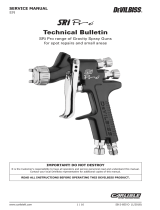 DeVilbiss SRiPro™ Spot Repair Manuel utilisateur
DeVilbiss SRiPro™ Spot Repair Manuel utilisateur
-
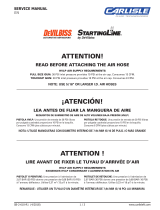 DeVilbiss 802343 Mode d'emploi
DeVilbiss 802343 Mode d'emploi
-
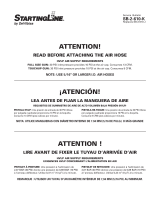 DeVilbiss 802342 Guide d'installation
DeVilbiss 802342 Guide d'installation
-
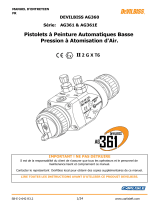 DeVilbiss AG360 Series Automatic Guns Le manuel du propriétaire
DeVilbiss AG360 Series Automatic Guns Le manuel du propriétaire
-
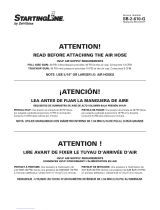 DeVilbiss StartingLine 802789 Manuel utilisateur
DeVilbiss StartingLine 802789 Manuel utilisateur
-
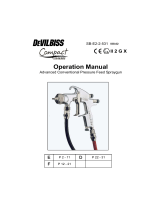 DeVilbiss SB-E2-2-531 Manuel utilisateur
DeVilbiss SB-E2-2-531 Manuel utilisateur
-
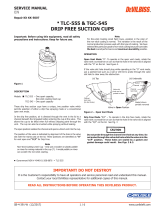 DeVilbiss Suction Feed Cups Manuel utilisateur
DeVilbiss Suction Feed Cups Manuel utilisateur
-
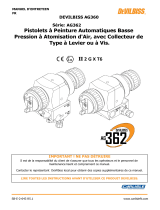 DeVilbiss AG 362 Le manuel du propriétaire
DeVilbiss AG 362 Le manuel du propriétaire
-
 DeVilbiss 130526 Service Instruction
DeVilbiss 130526 Service Instruction
Autres documents
-
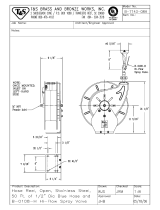 T & S Brass & Bronze Works B-7143-08H Fiche technique
T & S Brass & Bronze Works B-7143-08H Fiche technique
-
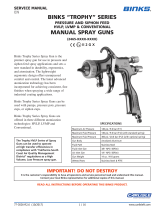 Binks Pogo Pump Outfits Manuel utilisateur
Binks Pogo Pump Outfits Manuel utilisateur
-
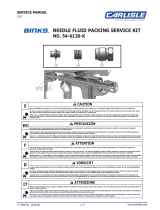 Binks Trophy Series Manuel utilisateur
Binks Trophy Series Manuel utilisateur
-
Miele MLT 75 Manuel utilisateur
-
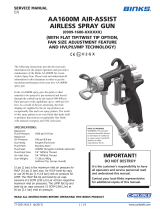 Binks AA1600M Manuel utilisateur
Binks AA1600M Manuel utilisateur
-
3M Accuspray™ ONE Spray Gun Kit Mode d'emploi
-
Carlisle DeVILBISS - PROLite Pressure and Suction Manuel utilisateur
-
Binks Pressure Cup Outfits Manuel utilisateur
-
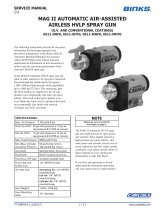 Binks MAG II Spray Gun Manuel utilisateur
Binks MAG II Spray Gun Manuel utilisateur
-
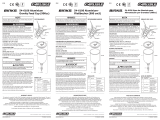 Binks Cups & Accessories Manuel utilisateur
Binks Cups & Accessories Manuel utilisateur






















































































